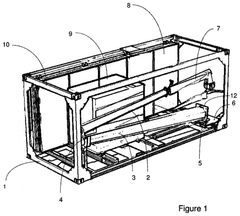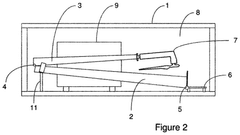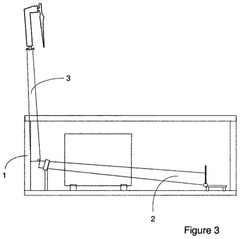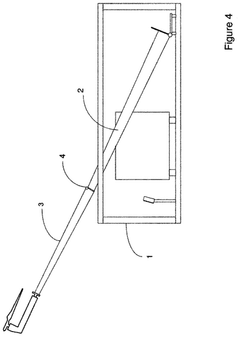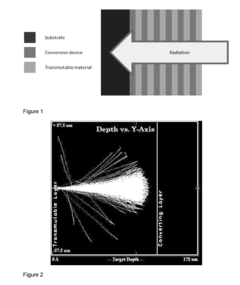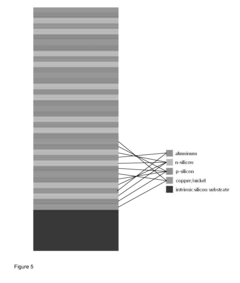How Isobutane Drives Innovation in Portable Power Generation
JUL 24, 20259 MIN READ
Generate Your Research Report Instantly with AI Agent
Patsnap Eureka helps you evaluate technical feasibility & market potential.
Isobutane Power Gen Background and Objectives
Isobutane has emerged as a key player in the evolution of portable power generation, marking a significant shift in the energy landscape. This hydrocarbon compound, with its unique properties, has opened new avenues for innovation in compact and efficient power solutions. The journey of isobutane in power generation can be traced back to the mid-20th century, but its potential in portable applications has only recently been fully realized.
The development of isobutane-based power generation technologies has been driven by the growing demand for mobile energy sources in various sectors, including outdoor recreation, emergency response, and remote industrial operations. As traditional power sources faced limitations in portability and efficiency, researchers and engineers turned to isobutane as a promising alternative. Its high energy density, low boiling point, and clean-burning characteristics made it an ideal candidate for small-scale power generation.
The evolution of isobutane power generation has been marked by several key milestones. Initially, the focus was on developing safe and reliable storage systems for the volatile compound. This was followed by advancements in combustion technology, allowing for more efficient energy extraction. The integration of miniaturized turbines and generators specifically designed for isobutane systems represented a significant leap forward, enabling the creation of truly portable power units.
Recent years have seen a surge in research aimed at optimizing isobutane-based power systems. The primary objectives of these efforts include enhancing energy conversion efficiency, reducing emissions, and improving overall system reliability. Researchers are exploring novel catalysts and combustion chamber designs to maximize power output while minimizing fuel consumption. Additionally, there is a growing emphasis on developing hybrid systems that combine isobutane generators with renewable energy sources, such as solar panels, to create more sustainable and versatile power solutions.
The current technological landscape is characterized by a push towards miniaturization and increased power density. Engineers are working on compact designs that can deliver higher power outputs without compromising portability. This trend is particularly evident in the development of micro-turbines and thermoelectric generators optimized for isobutane fuel. Concurrently, there is a focus on improving the safety features of these systems, addressing concerns related to fuel storage and handling in portable applications.
Looking ahead, the future of isobutane-driven portable power generation is poised for further innovation. The industry is setting ambitious targets for increasing energy efficiency, with some projections suggesting that next-generation systems could achieve conversion rates of up to 40%. There is also a growing interest in exploring the potential of isobutane in fuel cell technologies, which could revolutionize portable power generation by offering even higher efficiencies and lower emissions.
The development of isobutane-based power generation technologies has been driven by the growing demand for mobile energy sources in various sectors, including outdoor recreation, emergency response, and remote industrial operations. As traditional power sources faced limitations in portability and efficiency, researchers and engineers turned to isobutane as a promising alternative. Its high energy density, low boiling point, and clean-burning characteristics made it an ideal candidate for small-scale power generation.
The evolution of isobutane power generation has been marked by several key milestones. Initially, the focus was on developing safe and reliable storage systems for the volatile compound. This was followed by advancements in combustion technology, allowing for more efficient energy extraction. The integration of miniaturized turbines and generators specifically designed for isobutane systems represented a significant leap forward, enabling the creation of truly portable power units.
Recent years have seen a surge in research aimed at optimizing isobutane-based power systems. The primary objectives of these efforts include enhancing energy conversion efficiency, reducing emissions, and improving overall system reliability. Researchers are exploring novel catalysts and combustion chamber designs to maximize power output while minimizing fuel consumption. Additionally, there is a growing emphasis on developing hybrid systems that combine isobutane generators with renewable energy sources, such as solar panels, to create more sustainable and versatile power solutions.
The current technological landscape is characterized by a push towards miniaturization and increased power density. Engineers are working on compact designs that can deliver higher power outputs without compromising portability. This trend is particularly evident in the development of micro-turbines and thermoelectric generators optimized for isobutane fuel. Concurrently, there is a focus on improving the safety features of these systems, addressing concerns related to fuel storage and handling in portable applications.
Looking ahead, the future of isobutane-driven portable power generation is poised for further innovation. The industry is setting ambitious targets for increasing energy efficiency, with some projections suggesting that next-generation systems could achieve conversion rates of up to 40%. There is also a growing interest in exploring the potential of isobutane in fuel cell technologies, which could revolutionize portable power generation by offering even higher efficiencies and lower emissions.
Portable Power Market Analysis
The portable power generation market has experienced significant growth in recent years, driven by increasing demand for off-grid and emergency power solutions. This market encompasses a wide range of products, from small handheld devices to larger portable generators, catering to various consumer and industrial needs. The global portable power market was valued at approximately $4.5 billion in 2020 and is projected to reach $7.2 billion by 2027, growing at a CAGR of around 6.8% during the forecast period.
Several factors contribute to the expanding market for portable power solutions. The rise in outdoor recreational activities, such as camping and hiking, has fueled demand for compact and lightweight power sources. Additionally, the increasing frequency of natural disasters and power outages has heightened awareness of the need for reliable backup power systems. The growing adoption of mobile devices and the need for on-the-go charging solutions have further bolstered market growth.
In the context of isobutane-driven innovation, the market analysis reveals a growing interest in fuel cell technologies that utilize this hydrocarbon as a fuel source. Isobutane offers several advantages over traditional fuel sources, including higher energy density, lower emissions, and improved safety profiles. These characteristics make it particularly attractive for portable power applications, where size, weight, and environmental considerations are crucial factors.
The market for isobutane-based portable power solutions is still in its early stages but shows promising growth potential. Early adopters include outdoor enthusiasts, emergency response teams, and remote workers who require reliable and efficient power sources in off-grid locations. As the technology matures and becomes more cost-effective, it is expected to penetrate broader consumer markets and potentially disrupt traditional portable power generation methods.
Geographically, North America and Europe currently lead in the adoption of innovative portable power solutions, including those utilizing isobutane. However, rapid urbanization and increasing disposable incomes in Asia-Pacific regions are expected to drive significant market growth in the coming years. Emerging economies in these regions present substantial opportunities for market expansion, particularly as awareness of clean energy solutions grows.
Key players in the portable power market are investing heavily in research and development to capitalize on the potential of isobutane-based technologies. This investment is driving innovation in fuel cell design, storage solutions, and overall system efficiency. As a result, the market is witnessing the introduction of more compact, efficient, and user-friendly portable power products that leverage the benefits of isobutane as a fuel source.
Several factors contribute to the expanding market for portable power solutions. The rise in outdoor recreational activities, such as camping and hiking, has fueled demand for compact and lightweight power sources. Additionally, the increasing frequency of natural disasters and power outages has heightened awareness of the need for reliable backup power systems. The growing adoption of mobile devices and the need for on-the-go charging solutions have further bolstered market growth.
In the context of isobutane-driven innovation, the market analysis reveals a growing interest in fuel cell technologies that utilize this hydrocarbon as a fuel source. Isobutane offers several advantages over traditional fuel sources, including higher energy density, lower emissions, and improved safety profiles. These characteristics make it particularly attractive for portable power applications, where size, weight, and environmental considerations are crucial factors.
The market for isobutane-based portable power solutions is still in its early stages but shows promising growth potential. Early adopters include outdoor enthusiasts, emergency response teams, and remote workers who require reliable and efficient power sources in off-grid locations. As the technology matures and becomes more cost-effective, it is expected to penetrate broader consumer markets and potentially disrupt traditional portable power generation methods.
Geographically, North America and Europe currently lead in the adoption of innovative portable power solutions, including those utilizing isobutane. However, rapid urbanization and increasing disposable incomes in Asia-Pacific regions are expected to drive significant market growth in the coming years. Emerging economies in these regions present substantial opportunities for market expansion, particularly as awareness of clean energy solutions grows.
Key players in the portable power market are investing heavily in research and development to capitalize on the potential of isobutane-based technologies. This investment is driving innovation in fuel cell design, storage solutions, and overall system efficiency. As a result, the market is witnessing the introduction of more compact, efficient, and user-friendly portable power products that leverage the benefits of isobutane as a fuel source.
Isobutane Tech Challenges
The development of portable power generation using isobutane faces several significant technical challenges. One of the primary obstacles is the efficient conversion of isobutane's chemical energy into electrical power. Current technologies struggle to achieve high conversion efficiencies, limiting the overall performance of portable generators.
Another major challenge lies in the safe storage and handling of isobutane. As a highly flammable gas, isobutane requires robust containment systems to prevent leaks and minimize explosion risks. This necessitates the development of advanced materials and designs for fuel tanks and delivery systems that can withstand varying pressures and temperatures while maintaining structural integrity.
Heat management presents a substantial hurdle in isobutane-based power generation. The combustion of isobutane produces significant heat, which must be effectively dissipated to maintain optimal operating conditions and prevent system damage. Designing compact and efficient cooling mechanisms for portable applications remains a complex engineering task.
Miniaturization of isobutane power generation systems poses another technical challenge. Reducing the size and weight of components while maintaining performance is crucial for portable applications. This includes developing smaller, more efficient combustion chambers, turbines, and generators without compromising power output or reliability.
Emissions control is an increasingly important consideration in isobutane-based power generation. Developing clean-burning technologies that minimize harmful exhaust gases and particulate matter is essential for meeting stringent environmental regulations and ensuring widespread adoption of these portable power solutions.
The integration of smart control systems and power management technologies presents additional challenges. Optimizing fuel consumption, adjusting power output based on demand, and ensuring stable operation under varying load conditions require sophisticated electronic control units and sensors, which must be ruggedized for portable use.
Lastly, the development of cost-effective manufacturing processes for isobutane-based portable generators remains a significant challenge. Balancing performance, safety, and affordability is crucial for market penetration and widespread adoption of this technology in portable power generation applications.
Another major challenge lies in the safe storage and handling of isobutane. As a highly flammable gas, isobutane requires robust containment systems to prevent leaks and minimize explosion risks. This necessitates the development of advanced materials and designs for fuel tanks and delivery systems that can withstand varying pressures and temperatures while maintaining structural integrity.
Heat management presents a substantial hurdle in isobutane-based power generation. The combustion of isobutane produces significant heat, which must be effectively dissipated to maintain optimal operating conditions and prevent system damage. Designing compact and efficient cooling mechanisms for portable applications remains a complex engineering task.
Miniaturization of isobutane power generation systems poses another technical challenge. Reducing the size and weight of components while maintaining performance is crucial for portable applications. This includes developing smaller, more efficient combustion chambers, turbines, and generators without compromising power output or reliability.
Emissions control is an increasingly important consideration in isobutane-based power generation. Developing clean-burning technologies that minimize harmful exhaust gases and particulate matter is essential for meeting stringent environmental regulations and ensuring widespread adoption of these portable power solutions.
The integration of smart control systems and power management technologies presents additional challenges. Optimizing fuel consumption, adjusting power output based on demand, and ensuring stable operation under varying load conditions require sophisticated electronic control units and sensors, which must be ruggedized for portable use.
Lastly, the development of cost-effective manufacturing processes for isobutane-based portable generators remains a significant challenge. Balancing performance, safety, and affordability is crucial for market penetration and widespread adoption of this technology in portable power generation applications.
Current Isobutane Power Solutions
01 Isobutane production processes
Various innovative methods for producing isobutane have been developed, including catalytic processes, isomerization of n-butane, and dehydrogenation reactions. These processes aim to improve yield, efficiency, and selectivity in isobutane production, often utilizing novel catalysts or reaction conditions.- Isobutane production processes: Various innovative processes for producing isobutane have been developed. These include methods for isomerizing n-butane to isobutane, catalytic dehydrogenation of isobutane, and separation techniques to isolate isobutane from mixed hydrocarbon streams. These processes aim to improve yield, efficiency, and purity of isobutane production.
- Applications of isobutane in refrigeration and aerosols: Isobutane has found innovative applications in refrigeration systems and aerosol propellants. Its use as a more environmentally friendly alternative to traditional refrigerants and propellants has led to developments in formulation and containment technologies. These innovations focus on improving energy efficiency and reducing environmental impact.
- Isobutane in fuel blends and energy applications: Innovations in using isobutane for fuel blends and energy applications have emerged. These include incorporating isobutane into liquefied petroleum gas (LPG) mixtures, using it as a component in high-octane fuels, and exploring its potential in energy storage systems. The focus is on enhancing fuel efficiency and reducing emissions.
- Isobutane in chemical synthesis and industrial processes: Isobutane serves as a key raw material in various chemical synthesis and industrial processes. Innovations in this area include new catalytic processes for converting isobutane to higher-value chemicals, its use in polymer production, and novel applications in the petrochemical industry. These developments aim to improve process efficiency and product quality.
- Safety and handling innovations for isobutane: Given the flammable nature of isobutane, innovations in safety and handling techniques have been developed. These include improved storage and transportation methods, leak detection systems, and risk assessment tools. The focus is on enhancing safety measures and minimizing potential hazards associated with isobutane use across various industries.
02 Applications of isobutane in refrigeration and aerosols
Isobutane has found innovative applications in refrigeration systems and aerosol propellants due to its favorable thermodynamic properties and low environmental impact. Research focuses on optimizing its use in these areas, including improving energy efficiency and developing safer formulations.Expand Specific Solutions03 Isobutane in fuel blends and energy storage
Innovations in using isobutane as a component in fuel blends for internal combustion engines and as an energy storage medium have been explored. These developments aim to improve fuel efficiency, reduce emissions, and enhance energy storage capabilities in various applications.Expand Specific Solutions04 Isobutane in chemical synthesis and industrial processes
Isobutane serves as a key raw material in various chemical synthesis routes and industrial processes. Innovations in this area focus on developing new reaction pathways, improving catalysts, and optimizing process conditions to enhance the efficiency and sustainability of isobutane-based chemical production.Expand Specific Solutions05 Safety and environmental considerations in isobutane handling
Innovations in safety measures and environmental protection related to isobutane handling and use have been developed. These include improved storage and transportation methods, leak detection systems, and strategies to minimize environmental impact and enhance workplace safety when dealing with isobutane.Expand Specific Solutions
Key Players in Portable Power Industry
The isobutane-driven portable power generation market is in a growth phase, with increasing demand for efficient and compact energy solutions. The market size is expanding, driven by the need for off-grid power in various applications. Technologically, the field is advancing rapidly, with companies like China Petroleum & Chemical Corp. and Gevo, Inc. leading innovation. These firms are developing more efficient isobutane-based systems and exploring sustainable production methods. Research institutions such as Shanghai Petrochemical Research Institute and UOP LLC are contributing to technological advancements, focusing on improving efficiency and reducing environmental impact. The competitive landscape is diverse, with both established petrochemical giants and specialized renewable energy companies vying for market share.
China Petroleum & Chemical Corp.
Technical Solution: China Petroleum & Chemical Corp. (Sinopec) has been at the forefront of isobutane-based innovation in portable power generation. Their approach involves developing advanced catalytic processes for isobutane dehydrogenation, which produces isobutylene, a key component in the production of high-octane gasoline and other petrochemicals[1]. This process enhances the efficiency of portable power generation by providing a more energy-dense fuel source. Sinopec has also invested in the development of micro-turbines that can efficiently utilize isobutane as a fuel, resulting in compact and powerful portable generators[3]. These generators boast a higher power-to-weight ratio compared to traditional diesel generators, making them ideal for remote locations and emergency situations[5].
Strengths: Extensive petrochemical expertise, large-scale production capabilities, and advanced catalytic technologies. Weaknesses: Potential environmental concerns related to fossil fuel usage and emissions from isobutane-based systems.
Gevo, Inc.
Technical Solution: Gevo, Inc. has pioneered a unique approach to isobutane-driven portable power generation by focusing on renewable isobutanol production. Their patented GIFT® (Gevo Integrated Fermentation Technology) process converts plant-based sugars into isobutanol, which can be further processed into renewable isobutane[2]. This bio-based isobutane serves as a drop-in replacement for traditional petroleum-derived isobutane in portable power generation applications. Gevo's technology allows for the production of isobutane with a significantly reduced carbon footprint, addressing both energy density and sustainability concerns[4]. The company has also developed specialized fuel cells that can efficiently utilize their renewable isobutane, offering a clean and portable power solution for off-grid applications[6].
Strengths: Renewable and sustainable approach, reduced carbon footprint, and potential for integration with existing infrastructure. Weaknesses: Higher production costs compared to traditional petroleum-based isobutane and limited scale of production.
Isobutane Power Gen Innovations
Portable power generation system
PatentPendingUS20250003389A1
Innovation
- A portable power generation system featuring a transportable structure with a collapsible, pivotally connected tower for wind turbines and expandable solar panels, allowing for rapid erection and deployment without external foundations or wiring, utilizing a winch and cable system or linear actuators for tower extension and solar panel expansion.
Mass production method of loading radioisotopes into radiovoltaics
PatentInactiveUS20170032862A1
Innovation
- A method for producing integrated circuit-type active radioisotope batteries by fabricating unactivated batteries using non-radioactive materials and activating them post-fabrication through irradiation, allowing for automation, reduced hazardous waste, and improved integration with electronic devices.
Environmental Impact Assessment
The environmental impact of isobutane in portable power generation is a critical consideration for both manufacturers and consumers. Isobutane, a hydrocarbon refrigerant, has gained popularity in recent years due to its efficiency and low global warming potential compared to traditional refrigerants. However, its use in portable power generation systems still raises environmental concerns that require careful assessment.
One of the primary environmental advantages of isobutane is its significantly lower global warming potential (GWP) compared to conventional refrigerants. With a GWP of just 3, isobutane has a minimal impact on climate change when released into the atmosphere. This characteristic makes it an attractive option for environmentally conscious power generation solutions, particularly in portable applications where emissions are more likely to occur.
Despite its low GWP, isobutane is still a volatile organic compound (VOC) and can contribute to ground-level ozone formation if released in significant quantities. This potential for air quality degradation must be carefully managed through proper design, maintenance, and disposal practices for isobutane-based power generation systems. Manufacturers must implement robust containment measures to minimize leaks and emissions during operation and end-of-life disposal.
Water pollution is another environmental concern associated with isobutane use in portable power generation. While isobutane itself is not water-soluble, any leaks or spills could potentially contaminate water sources if not properly contained. This risk necessitates the development of spill prevention and response protocols for both manufacturers and end-users of isobutane-powered generators.
The production and transportation of isobutane also have environmental implications. As a byproduct of natural gas processing and petroleum refining, the extraction and refinement of isobutane contribute to the overall carbon footprint of its lifecycle. However, the energy efficiency gains in power generation may offset these upstream impacts, particularly when compared to less efficient alternatives.
End-of-life management for isobutane-containing devices presents both challenges and opportunities from an environmental perspective. Proper recycling and disposal procedures are essential to prevent the release of isobutane into the atmosphere. Developing closed-loop recycling systems for isobutane recovery could significantly reduce the environmental impact of portable power generation devices throughout their lifecycle.
In conclusion, while isobutane offers several environmental benefits in portable power generation, particularly in terms of reduced global warming potential, its use still requires careful management to mitigate potential negative impacts on air quality, water resources, and overall ecosystem health. Ongoing research and development efforts should focus on further improving containment technologies, enhancing energy efficiency, and optimizing end-of-life management strategies to maximize the environmental benefits of isobutane-driven innovation in portable power generation.
One of the primary environmental advantages of isobutane is its significantly lower global warming potential (GWP) compared to conventional refrigerants. With a GWP of just 3, isobutane has a minimal impact on climate change when released into the atmosphere. This characteristic makes it an attractive option for environmentally conscious power generation solutions, particularly in portable applications where emissions are more likely to occur.
Despite its low GWP, isobutane is still a volatile organic compound (VOC) and can contribute to ground-level ozone formation if released in significant quantities. This potential for air quality degradation must be carefully managed through proper design, maintenance, and disposal practices for isobutane-based power generation systems. Manufacturers must implement robust containment measures to minimize leaks and emissions during operation and end-of-life disposal.
Water pollution is another environmental concern associated with isobutane use in portable power generation. While isobutane itself is not water-soluble, any leaks or spills could potentially contaminate water sources if not properly contained. This risk necessitates the development of spill prevention and response protocols for both manufacturers and end-users of isobutane-powered generators.
The production and transportation of isobutane also have environmental implications. As a byproduct of natural gas processing and petroleum refining, the extraction and refinement of isobutane contribute to the overall carbon footprint of its lifecycle. However, the energy efficiency gains in power generation may offset these upstream impacts, particularly when compared to less efficient alternatives.
End-of-life management for isobutane-containing devices presents both challenges and opportunities from an environmental perspective. Proper recycling and disposal procedures are essential to prevent the release of isobutane into the atmosphere. Developing closed-loop recycling systems for isobutane recovery could significantly reduce the environmental impact of portable power generation devices throughout their lifecycle.
In conclusion, while isobutane offers several environmental benefits in portable power generation, particularly in terms of reduced global warming potential, its use still requires careful management to mitigate potential negative impacts on air quality, water resources, and overall ecosystem health. Ongoing research and development efforts should focus on further improving containment technologies, enhancing energy efficiency, and optimizing end-of-life management strategies to maximize the environmental benefits of isobutane-driven innovation in portable power generation.
Safety Regulations for Isobutane Use
The use of isobutane in portable power generation systems necessitates strict adherence to safety regulations due to its flammable nature. Regulatory bodies worldwide have established comprehensive guidelines to ensure the safe handling, storage, and utilization of isobutane in these applications. These regulations typically cover various aspects, including equipment design, manufacturing processes, transportation, and end-user operation.
One of the primary safety concerns addressed by regulations is the prevention of gas leaks. Manufacturers are required to implement robust sealing mechanisms and conduct rigorous leak detection tests during production. Additionally, portable power generation units must incorporate pressure relief valves and automatic shut-off systems to mitigate the risk of over-pressurization and potential explosions.
Storage and transportation of isobutane-powered devices are subject to specific requirements. Regulations often mandate the use of specialized containers designed to withstand pressure and impact, as well as proper labeling to indicate the presence of flammable materials. Restrictions on the quantity of isobutane that can be transported or stored in a single location are also common to minimize potential hazards.
For end-users, safety regulations emphasize proper operation and maintenance procedures. Manufacturers are obligated to provide clear instructions and warnings regarding the safe use of isobutane-powered devices. This includes guidelines for refilling, storage, and disposal of empty containers. Many jurisdictions require user manuals to include prominent safety warnings and step-by-step instructions for safe operation.
Environmental considerations are also addressed in safety regulations for isobutane use. Measures to prevent accidental releases into the atmosphere and proper disposal methods for spent fuel containers are typically mandated. Some regulations may require manufacturers to implement recycling programs for used isobutane canisters to minimize environmental impact.
Compliance with these safety regulations often involves certification processes and regular inspections. Manufacturers must demonstrate that their products meet all applicable safety standards before they can be marketed. Ongoing compliance monitoring and periodic safety audits are common requirements to ensure continued adherence to regulations throughout the product lifecycle.
As the technology for portable power generation using isobutane continues to evolve, safety regulations are regularly reviewed and updated. Regulatory bodies work closely with industry experts and researchers to address emerging safety concerns and incorporate new safety technologies into their guidelines. This ongoing process ensures that safety standards keep pace with technological advancements in the field of portable power generation.
One of the primary safety concerns addressed by regulations is the prevention of gas leaks. Manufacturers are required to implement robust sealing mechanisms and conduct rigorous leak detection tests during production. Additionally, portable power generation units must incorporate pressure relief valves and automatic shut-off systems to mitigate the risk of over-pressurization and potential explosions.
Storage and transportation of isobutane-powered devices are subject to specific requirements. Regulations often mandate the use of specialized containers designed to withstand pressure and impact, as well as proper labeling to indicate the presence of flammable materials. Restrictions on the quantity of isobutane that can be transported or stored in a single location are also common to minimize potential hazards.
For end-users, safety regulations emphasize proper operation and maintenance procedures. Manufacturers are obligated to provide clear instructions and warnings regarding the safe use of isobutane-powered devices. This includes guidelines for refilling, storage, and disposal of empty containers. Many jurisdictions require user manuals to include prominent safety warnings and step-by-step instructions for safe operation.
Environmental considerations are also addressed in safety regulations for isobutane use. Measures to prevent accidental releases into the atmosphere and proper disposal methods for spent fuel containers are typically mandated. Some regulations may require manufacturers to implement recycling programs for used isobutane canisters to minimize environmental impact.
Compliance with these safety regulations often involves certification processes and regular inspections. Manufacturers must demonstrate that their products meet all applicable safety standards before they can be marketed. Ongoing compliance monitoring and periodic safety audits are common requirements to ensure continued adherence to regulations throughout the product lifecycle.
As the technology for portable power generation using isobutane continues to evolve, safety regulations are regularly reviewed and updated. Regulatory bodies work closely with industry experts and researchers to address emerging safety concerns and incorporate new safety technologies into their guidelines. This ongoing process ensures that safety standards keep pace with technological advancements in the field of portable power generation.
Unlock deeper insights with Patsnap Eureka Quick Research — get a full tech report to explore trends and direct your research. Try now!
Generate Your Research Report Instantly with AI Agent
Supercharge your innovation with Patsnap Eureka AI Agent Platform!
